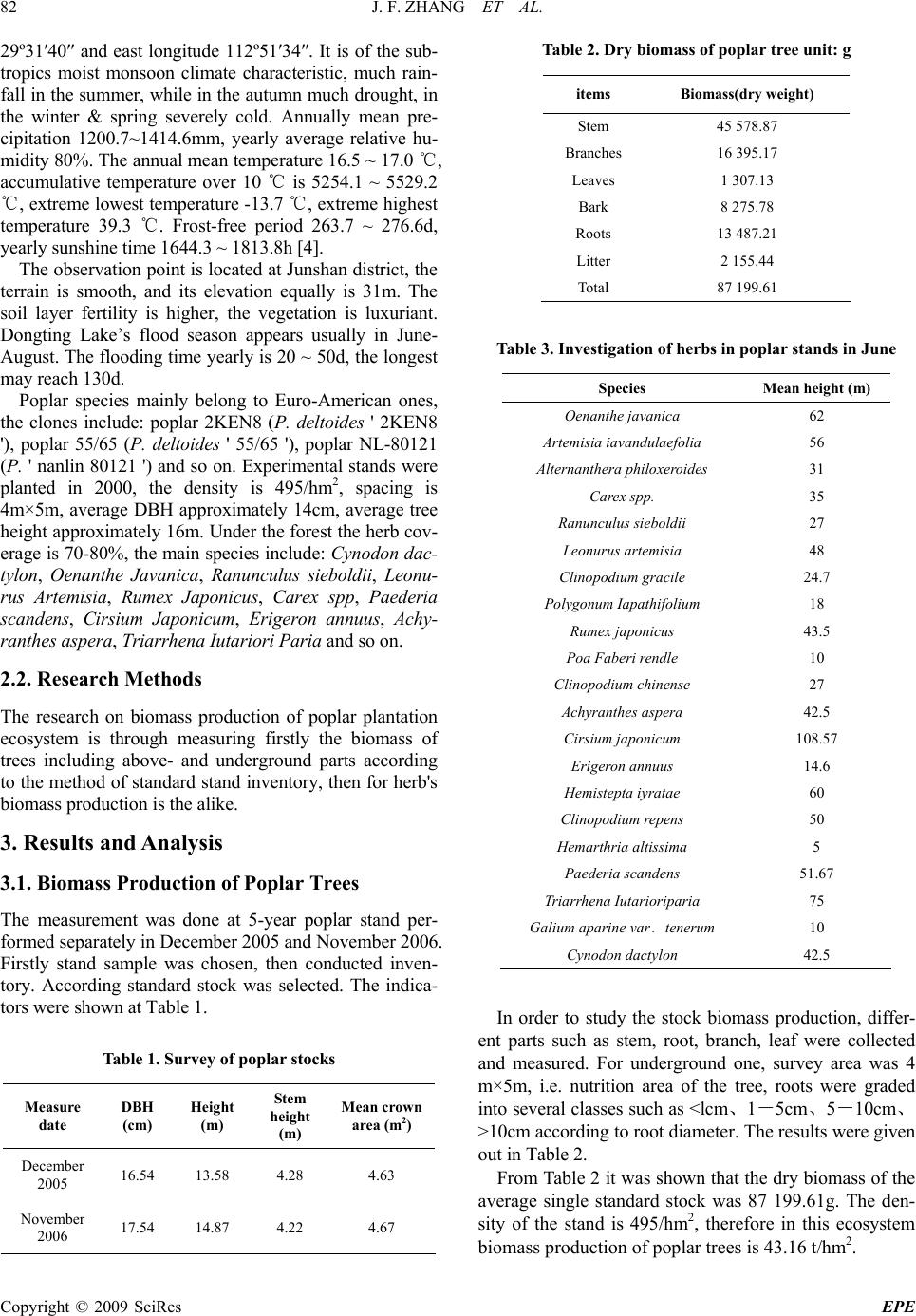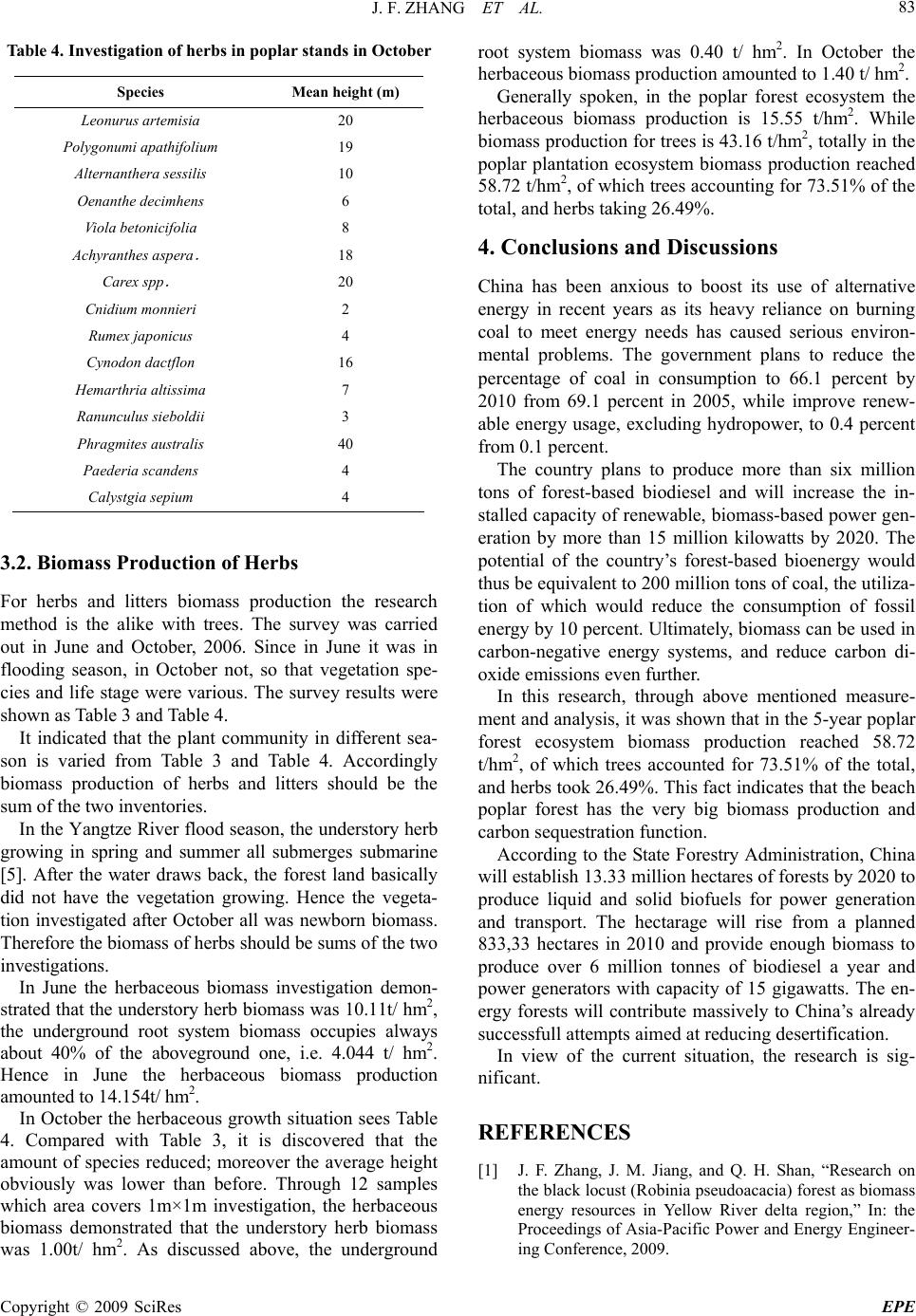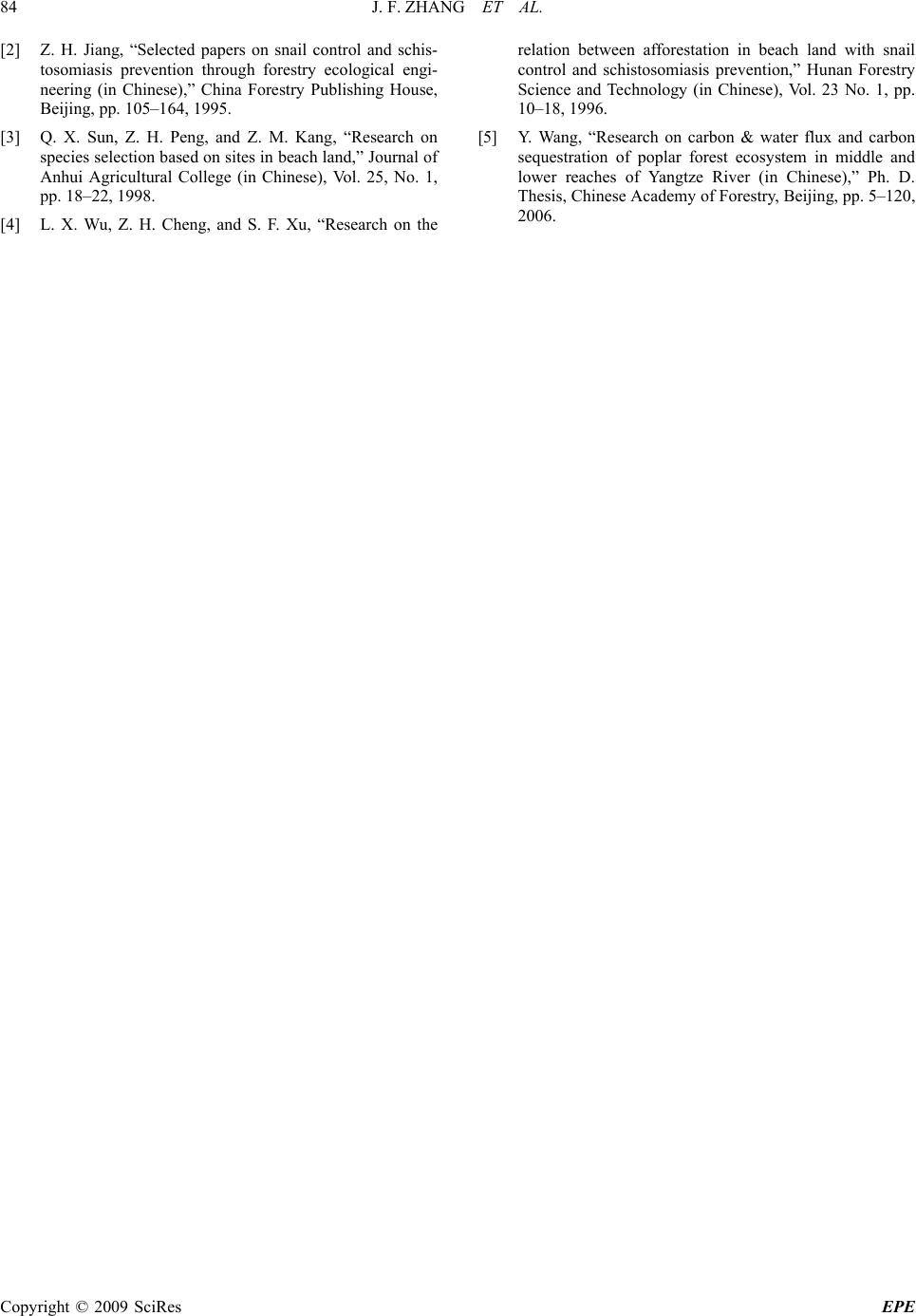Paper Menu >>
Journal Menu >>
 Energy and Power Engineering, 2009, 81-84 doi:10.4236/epe.2009.12012 Published Online November 2009 (http://www.scirp.org/journal/epe) Copyright © 2009 SciRes EPE Biomass Production of Poplar Plantation Ecosystem in Yangtze River Beach Land Jianfeng ZHANG1, Qixiang SUN2,*, Jinxing ZHOU2, Qihua SHAN1, Lixun WU3 1Institute of Subtropical Forestry, Chinese Academy of Forestry, Fuyang, China 2Institute of Forestry, CAF, Silvicultural Laboratory of SFA, Beijing, China 3Forestry Academy of Hunan, Changsha, China *Author for corresponding, Email: sunqixiang@263.net Abstract: Currently, China is home to more than four million hectares of oil plants nationwide, and 154 kinds of energy trees could produce seeds containing more than 40 percent of oil, with total production of the seeds totaling five million tons. Another 57 million hectares of waste land are available and suitable for planting trees for the production of forest-based bioenergy, of which there is 630,000 hm2 beach land in the middle and lower reaches of Yangtze River where is suited for poplar growing. In order to approach the po- tential of poplar biomass production, the test was conducted in the paper. The result indicated that in the poplar forest ecosystem the herbaceous biomass production was 15.554 t/hm2. While biomass production for trees was 43.164 t/hm2, totally in the poplar plantation ecosystem biomass production reached 58.718 t/hm2. As well, poplars growing added incomes for local farmers. Keywords: biomass production, poplar plantation, Yangtze River 1. Introduction Based on abundant information from the National Bureau of Statistics and listed companies, in 2007, China’s fuel ethanol output reached 1.6 million tons, of which 80% used corn as raw materials. Based on the proportion 1:3.3, more than four million tons of corn was consumed. It is estimated that China’s annual fuel ethanol output will reach five million tons in 2010 and utilization rate of ethanol gasoline will be more than 50%. Moreover, corn- based ethanol has stopped expanding production capacity, as government policies have clearly restricted the devel- opment of grain-based ethanol. Therefore, developing non-grain ethanol has become an inevitable trend [1]. It is forecasted that China’s biodiesel output will reach two million tons in 2010. China’s biological energy power generation has devel- oped rapidly and the total installed capacity has reached 2.2 million kW, of which 1.7 million KW was from Ba- gasse co-generation and 500,000 KW was powered by agriculture and forestry wastes, methane, direct-burning of rubbish and landfill gas. Generally speaking, efforts made to develop biological energy are still limited, there- fore, China’s bioenergy has a huge potential for future development. China has sufficient raw materials resources for pro- duction of biomass. Only the agricultural wastes can be converted into energy, which is equivalent to 500 million tons of standard coal and 350 million tons of crude oil (about 2.5 billion barrels). There is 630,000 hm2 beach land in the middle and lower reaches of Yangtze River, including island-type beach, the continent beach, the lake beach, etc. three kind of types. This is the extremely important natural resource in view of much more population and faster urban expan- sion there [2]. But because natural vicissitude, mainly the human factor disturbance, the beach land ecosystem is received the enormous destruction, cannot display the ecological function, the economic benefits and the social efficiency which it should have. On the other hand, planting poplar tree in the beach, not only fully uses the natural resource, increases the in- comes for local people, moreover the poplar tree also has the function of biomass production. Therefore, the de- velopment of poplar forest in the beach could improve the local ecological environment along the middle and lower reaches of Yangtze River, and promote regional socio- economic processing as well [3]. 2. Experimental Location and Methods 2.1. Experimental Location and Natural Conditions The research is funded by State Tenth Five-year Plan of Science & Technolo gy Pro j ect ( 2006BAD03A15 ) Experimental location lied at Dongting lake region in Yueyang, Hunan Province, among the north latitude  J. F. ZHANG ET AL. 82 29º31′40″ and east longitude 112º51′34″. It is of the sub- tropics moist monsoon climate characteristic, much rain- fall in the summer, while in the autumn much drought, in the winter & spring severely cold. Annually mean pre- cipitation 1200.7~1414.6mm, yearly average relative hu- midity 80%. The annual mean temperature 16.5 ~ 17.0 , ℃ accumulative temperature over 10 is 5254.1 ~ 5529.2 ℃ , extreme lowest temperature ℃-13.7 , extreme highest ℃ temperature 39.3 . Frost℃-free period 263.7 ~ 276.6d, yearly sunshine time 1644.3 ~ 1813.8h [4]. The observation point is located at Junshan district, the terrain is smooth, and its elevation equally is 31m. The soil layer fertility is higher, the vegetation is luxuriant. Dongting Lake’s flood season appears usually in June- August. The flooding time yearly is 20 ~ 50d, the longest may reach 130d. Poplar species mainly belong to Euro-American ones, the clones include: poplar 2KEN8 (P. deltoides ' 2KEN8 '), poplar 55/65 (P. deltoides ' 55/65 '), poplar NL-80121 (P. ' nanlin 80121 ') and so on. Experimental stands were planted in 2000, the density is 495/hm2, spacing is 4m×5m, average DBH approximately 14cm, average tree height approximately 16m. Under the forest the herb cov- erage is 70-80%, the main species include: Cynodon dac- tylon, Oenanthe Javanica, Ranunculus sieboldii, Leonu- rus Artemisia, Rumex Japonicus, Carex spp, Paederia scandens, Cirsium Japonicum, Erigeron annuus, Achy- ranthes aspera, Triarrhena Iutariori Paria and so on. 2.2. Research Methods The research on biomass production of poplar plantation ecosystem is through measuring firstly the biomass of trees including above- and underground parts according to the method of standard stand inventory, then for herb's biomass production is the alike. 3. Results and Analysis 3.1. Biomass Production of Poplar Trees The measurement was done at 5-year poplar stand per- formed separately in December 2005 and November 2006. Firstly stand sample was chosen, then conducted inven- tory. According standard stock was selected. The indica- tors were shown at Table 1. Table 1. Survey of poplar stocks Measure date DBH (cm) Height (m) Stem height (m) Mean crown area (m2) December 2005 16.54 13.58 4.28 4.63 November 2006 17.54 14.87 4.22 4.67 Table 2. Dry biomass of poplar tree unit: g items Biomass(dry weight) Stem 45 578.87 Branches 16 395.17 Leaves 1 307.13 Bark 8 275.78 Roots 13 487.21 Litter 2 155.44 Total 87 199.61 Table 3. Investigation of herbs in poplar stands in June Species Mean height (m) Oenanthe javanica 62 Artemisia iavandulaefolia 56 Alternanthera philoxeroides 31 Carex spp. 35 Ranunculus sieboldii 27 Leonurus artemisia 48 Clinopodium gracile 24.7 Polygonum Iapathifolium 18 Rumex japonicus 43.5 Poa Faberi rendle 10 Clinopodium chinense 27 Achyranthes aspera 42.5 Cirsium japonicum 108.57 Erigeron annuus 14.6 Hemistepta iyratae 60 Clinopodium repens 50 Hemarthria altissima 5 Paederia scandens 51.67 Triarrhena Iutarioriparia 75 Galium aparine var . tenerum 10 Cynodon dactylon 42.5 In order to study the stock biomass production, differ- ent parts such as stem, root, branch, leaf were collected and measured. For underground one, survey area was 4 m×5m, i.e. nutrition area of the tree, roots were graded into several classes such as <lcm、1-5cm、5-10cm、 >10cm according to root diameter. The results were given out in Table 2. From Table 2 it was shown that the dry biomass of the average single standard stock was 87 199.61g. The den- sity of the stand is 495/hm2, therefore in this ecosystem biomass production of poplar trees is 43.16 t/hm2. Copyright © 2009 SciRes EPE  J. F. ZHANG ET AL. 83 Table 4. Investigation of herbs in poplar stands in October Species Mean height (m) Leonurus artemisia 20 Polygonumi apathifolium 19 Alternanthera sessilis 10 Oenanthe decimhens 6 Viola betonicifolia 8 Achyranthes aspera . 18 Carex spp . 20 Cnidium monnieri 2 Rumex japonicus 4 Cynodon dactflon 16 Hemarthria altissima 7 Ranunculus sieboldii 3 Phragmites australis 40 Paederia scandens 4 Calystgia sepium 4 3.2. Biomass Production of Herbs For herbs and litters biomass production the research method is the alike with trees. The survey was carried out in June and October, 2006. Since in June it was in flooding season, in October not, so that vegetation spe- cies and life stage were various. The survey results were shown as Table 3 and Table 4. It indicated that the plant community in different sea- son is varied from Table 3 and Table 4. Accordingly biomass production of herbs and litters should be the sum of the two inventories. In the Yangtze River flood season, the understory herb growing in spring and summer all submerges submarine [5]. After the water draws back, the forest land basically did not have the vegetation growing. Hence the vegeta- tion investigated after October all was newborn biomass. Therefore the biomass of herbs should be sums of the two investigations. In June the herbaceous biomass investigation demon- strated that the understory herb biomass was 10.11t/ hm2, the underground root system biomass occupies always about 40% of the aboveground one, i.e. 4.044 t/ hm2. Hence in June the herbaceous biomass production amounted to 14.154t/ hm2. In October the herbaceous growth situation sees Table 4. Compared with Table 3, it is discovered that the amount of species reduced; moreover the average height obviously was lower than before. Through 12 samples which area covers 1m×1m investigation, the herbaceous biomass demonstrated that the understory herb biomass was 1.00t/ hm2. As discussed above, the underground root system biomass was 0.40 t/ hm2. In October the herbaceous biomass production amounted to 1.40 t/ hm2. Generally spoken, in the poplar forest ecosystem the herbaceous biomass production is 15.55 t/hm2. While biomass production for trees is 43.16 t/hm2, totally in the poplar plantation ecosystem biomass production reached 58.72 t/hm2, of which trees accounting for 73.51% of the total, and herbs taking 26.49%. 4. Conclusions and Discussions China has been anxious to boost its use of alternative energy in recent years as its heavy reliance on burning coal to meet energy needs has caused serious environ- mental problems. The government plans to reduce the percentage of coal in consumption to 66.1 percent by 2010 from 69.1 percent in 2005, while improve renew- able energy usage, excluding hydropower, to 0.4 percent from 0.1 percent. The country plans to produce more than six million tons of forest-based biodiesel and will increase the in- stalled capacity of renewable, biomass-based power gen- eration by more than 15 million kilowatts by 2020. The potential of the country’s forest-based bioenergy would thus be equivalent to 200 million tons of coal, the utiliza- tion of which would reduce the consumption of fossil energy by 10 percent. Ultimately, biomass can be used in carbon-negative energy systems, and reduce carbon di- oxide emissions even further. In this research, through above mentioned measure- ment and analysis, it was shown that in the 5-year poplar forest ecosystem biomass production reached 58.72 t/hm2, of which trees accounted for 73.51% of the total, and herbs took 26.49%. This fact indicates that the beach poplar forest has the very big biomass production and carbon sequestration function. According to the State Forestry Administration, China will establish 13.33 million hectares of forests by 2020 to produce liquid and solid biofuels for power generation and transport. The hectarage will rise from a planned 833,33 hectares in 2010 and provide enough biomass to produce over 6 million tonnes of biodiesel a year and power generators with capacity of 15 gigawatts. The en- ergy forests will contribute massively to China’s already successfull attempts aimed at reducing desertification. In view of the current situation, the research is sig- nificant. REFERENCES [1] J. F. Zhang, J. M. Jiang, and Q. H. Shan, “Research on the black locust (Robinia pseudoacacia) forest as biomass energy resources in Yellow River delta region,” In: the Proceedings of Asia-Pacific Power and Energy Engineer- ing Conference, 2009. Copyright © 2009 SciRes EPE  J. F. ZHANG ET AL. Copyright © 2009 SciRes EPE 84 [2] Z. H. Jiang, “Selected papers on snail control and schis- tosomiasis prevention through forestry ecological engi- neering (in Chinese),” China Forestry Publishing House, Beijing, pp. 105–164, 1995. [3] Q. X. Sun, Z. H. Peng, and Z. M. Kang, “Research on species selection based on sites in beach land,” Journal of Anhui Agricultural College (in Chinese), Vol. 25, No. 1, pp. 18–22, 1998. [4] L. X. Wu, Z. H. Cheng, and S. F. Xu, “Research on the relation between afforestation in beach land with snail control and schistosomiasis prevention,” Hunan Forestry Science and Technology (in Chinese), Vol. 23 No. 1, pp. 10–18, 1996. [5] Y. Wang, “Research on carbon & water flux and carbon sequestration of poplar forest ecosystem in middle and lower reaches of Yangtze River (in Chinese),” Ph. D. Thesis, Chinese Academy of Forestry, Beijing, pp. 5–120, 2006. |

